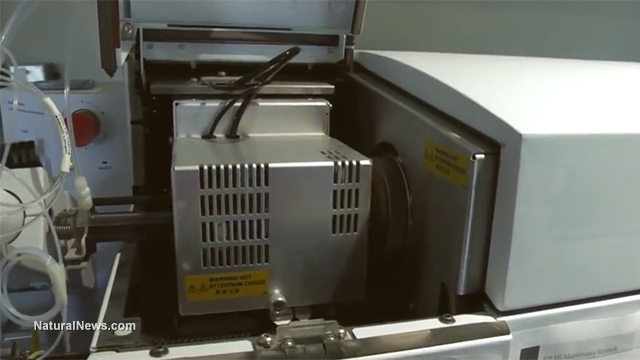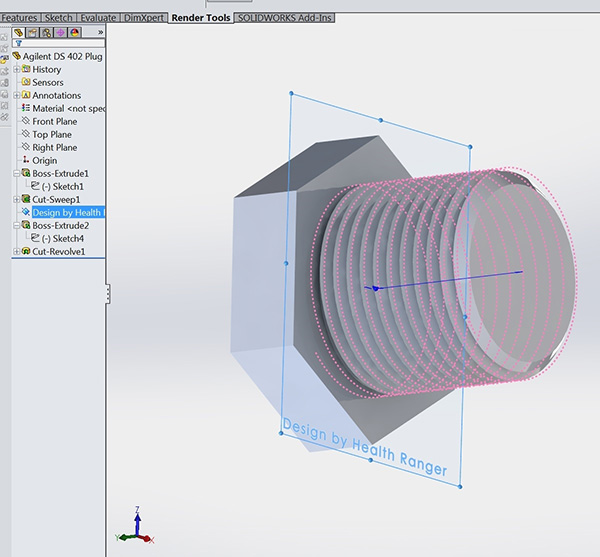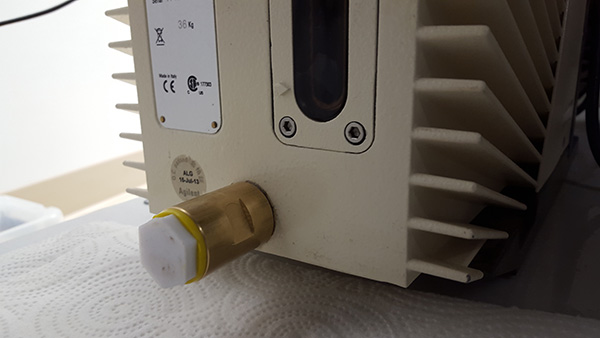Science labs across America need to start incorporating 3D printers to solve their problems
Tuesday, March 22, 2016 by: S. Johnson
Tags: Mike Adams, 3D printing, laboratory instrumentation

(NaturalNews) A new industrial revolution is brewing. Industrial 3D printing is making its way from the mainstream to the lab, enabling researchers to obtain parts for scientific instruments in an unprecedented way.
3D printing is already changing how various objects, including tools and clothing, are made. It is part of a process known as additive manufacturing, which creates an object by adding material layer by layer. Additive manufacturing allows scientists to create complex parts for scientific instruments at a fraction of the cost of conventional means.
"Instead of waiting for parts to be ordered and shipped, it's often easier and faster to just build the parts yourself in 3D software, then print those parts on a 3D printer," said Mike Adams, the Health Ranger, who runs his own forensic food lab.
When Adams needed a part to plug an oil drain on a vacuum pump for an Agilent 7700x ICP-MS instrument, he designed one and printed it out as seen in the pic below. Adams emphasizes that science labs across America need to start using 3D printers more to solve their problems.

How 3D printing works
The first step in 3D printing is to create a blueprint of the object you want to print. This is achieved using modeling software. Once a design is chosen, it can be sent to the printer. Plastic strands, known as filament, are usually on a spool attached to the printer. The filament is pulled through a tube, liquefied and deposited on a plate to cool. Adams co-developed a polymer filament called "T-glase polar white" to print his plug.
The 3D object is sculpted through layering. The printer lays down one layer of the object at a time until the structure is completely formed. When people first encounter a 3D printer, they ponder all the tailor-made products that could be made from it. Scientists have the same mentality. The only difference is that scientists tend to rely on equipment that is both expensive and highly specialized. In other words, 3D printing has the potential to change the way scientists do science.
Redefining how science is done
The price of 3D printers and filament will likely drop as they become manufactured on a larger scale. As researchers start to share designs from their laboratory hardware, other researchers can use and improve those designs. This will make scientific instruments affordable, not just for academics, but for public schools and citizen scientists conducting independent research.For ages, scientists had to purchase expensive tools and pay outrageously exorbitant fees if they wanted to do cutting edge research. This isn't the case in the wake of 3D printers, however. The technology will enable researchers to produce products in the comfort of a lab, sidestepping the stock, shipping and waste attached to other instruments.
Less money and more research time is just half of what 3D printers have to offer. The foremost benefit of 3D printers is their ability to produce tailor-made parts for scientific instruments. Rather than relying on what is commercially available, scientists can print out custom parts for scientific tools. This is particularly useful for scientists conducting cutting edge research, who need highly specialized instruments to make real scientific breakthroughs. In the meantime, universities across the country are wasting millions of dollars on repairing outdated scientific equipment.
In the long term, 3D printing will revolutionize science by blending scientific consumption with scientific production.
Sources include:
TechCrunch.com
Elsevier.com
Gigaom.com
HBR.org
Science.NaturalNews.com
Mike Adams at FETCH.news
Get independent news alerts on natural cures, food lab tests, cannabis medicine, science, robotics, drones, privacy and more.
Take Action: Support Natural News by linking to this article from your website
Permalink to this article:
Embed article link: (copy HTML code below):
Reprinting this article:
Non-commercial use OK, cite NaturalNews.com with clickable link.
Follow Natural News on Facebook, Twitter, Google Plus, and Pinterest
- Health benefits of Bromelain: An anti-inflammatory enzyme
- Study Finds Chinese Red Yeast Rice Good for Your Heart
- Depopulation globalist Bill Gates investing in meat alternatives made with toxic ingredients like GMO canola oil
- Bentonite Clay Provides a Safe and Effective Detox
- Magnesium and your health
- Cancer researchers announce breakthroughs in natural prostate cancer prevention and treatment
- History of Medicine: The former Chairman of Bayer, maker of children's aspirin, was found guilty of Nazi war crimes and sentenced to prison
- The remarkable health benefits of Epsom salt baths
- Astaxanthin: The Little-Known Miracle Nutrient for Inflammation, Anti-Aging, Athletic Endurance and More
- If given a fair choice, most consumers would choose alternative medicine over conventional health care
- Mindfulness therapy could make antidepressant drugs obsolete
- The best, and worst, laundry detergents with 1,4-dioxane contamination
- Natural remedies for acid reflux disease (GERD)
- Don't get the shot! US now protects Big Pharma from liability in Ebola vaccine deaths
- Salt - friend or foe?
- Top foods to avoid and to eat when diagnosed with atrial fibrillation
- Bill Gates GMO Zombie Eggs
- Q&A: How do I avoid atherosclerosis and improve cardiovascular health? What if I have been diagnosed with mitral valve prolapse?
- Curcumin slays cancer cells in their tracks
- The REAL FAKE NEWS exposed: '97% of scientists agree on climate change' is an engineered hoax... here's what the media never told you
- Amazing herbal cures from around the world
- The remarkable health benefits of Epsom salt baths
- Omega-3s dramatically inhibit breast cancer tumor growth
- A War is against Your Immune System, Part I
- What's really in vaccines? Proof of MSG, formaldehyde, aluminum and mercury
- Forbes.com writer and biotech shill Jon Entine exposed as violent instigator who physically attacked wife and traumatized daughter - court documents
- Lymphatic vessels acknowledged in the brain; could be the key to better understanding disease
- Beat cancer with 35% hydrogen peroxide
- Canadian agency attacks Jenny McCarthy for demanding mercury-free vaccines
- Improve your diet with nutritious homemade ketchup
- Natural ways to move mucus and expel phlegm
- The United Nations 2030 Agenda decoded: It's a blueprint for the global enslavement of humanity under the boot of corporate masters
- Bill Gates says vaccines can help reduce world population
- Health benefits of Bromelain: An anti-inflammatory enzyme
- The top 10 best foods for burning belly fat
- The big lie of genetics exposed: human DNA incapable of storing complete blueprint of the human form
- The REAL FAKE NEWS exposed: '97% of scientists agree on climate change' is an engineered hoax... here's what the media never told you
- Red Cabbage Found to Contain 36 Anti-Cancer Anthocyanins
- Beat cancer with 35% hydrogen peroxide
- The 10 worst toxins hidden in vitamins, supplements and health foods
- Untested vaccines causing new wave of polio-like paralysis across India
- The United Nations 2030 Agenda decoded: It's a blueprint for the global enslavement of humanity under the boot of corporate masters
- Canadian agency attacks Jenny McCarthy for demanding mercury-free vaccines
- Bill Gates says vaccines can help reduce world population
- Curcumin slays cancer cells in their tracks
- Apricot Seeds Kill Cancer Cells without Side Effects
- Four supplements that will benefit almost everyone
- Top foods, herbs and supplements to keep on hand in the event of a nuclear crisis
- The best and worst forms of magnesium to take as a supplement
- Before his death, father of ADHD admitted it was a fictitious disease
- Vitamin E kills off cancer cells and prevents their reproduction, study finds
- Vaccines lower immunity
- 4 enzyme rich foods that can dramatically improve digestion
- Apple extract kills colon cancer cells better than chemo drug in latest study
- EPA advisor admits the agency is funneling billions to climate groups ahead of Trump’s return to White House
- Newly released JFK files reveal Pentagon's role in creating Lyme disease and covid in the same lab
- Eleven days before Iran bombed Tel Aviv, my microscope revealed haunting images of EXACTLY what would happen
- Morphic resonance “remote viewing” reveals iconic Middle East images of stealth bombers, a falcon and a one-horned ram
- Mike Adams releases country western hit single: Goin’ Back in Time is Comin’ Home
- DECENTRALIZED SPIRITUALITY and the true teachings of Christ: Overcoming the censorship, threats and lies of organized religion to truly know God and the Universal Christ
- Global leaders unite to clamp down on “misinformation” with UN-backed Cascais Declaration
- BOMBSHELL: Covid-19 mRNA nanoparticles EMIT LIGHT SIGNALS that communicate MAC addresses used for self-assembly inside the blood vessels
- I Want My Bailout Money – new song released by Mike Adams
- HEALTH SECRETS: How to Instantly Block MSG Toxicity Using Natural Substances (and the secret of Methylene Blue)
- Two containers with completed ballots fall out of truck in Florida
- The Health Ranger releases “Vaccine Zombie” song and music video, using AI-animated zombies for the music video
- BOMBSHELL: Internal Pfizer documents exposed and reveal at least 16 PERCENT of their mRNA vaccine "adverse events" are REPRODUCTIVE DISORDERS
- BOMBSHELL: DNA testing kits are a SCAM to develop ethnic-specific bioweapons
- HYSSOP: What research reveals about the health benefits of this ancient holy herb
- Amazing microscopy photos reveal how freezing crystals attempt to mimic electronic structures they are touching
- RFK Jr. clears key hurdle: Sen. Susan Collins backs controversial HHS nominee, signaling a new era for health policy
- The Coming Gold Revaluation: Strategic Financial Realignment in an Era of Dollar Collapse
Science News & Studies
Medicine News and Information
Food News & Studies
Health News & Studies
Herbs News & Information
Pollution News & Studies
Cancer News & Studies
Climate News & Studies
Survival News & Information
Gear News & Information
News covering technology, stocks, hackers, and more



"Big Tech and mainstream media are constantly trying to silence the independent voices that dare to bring you the truth about toxic food ingredients, dangerous medications and the failed, fraudulent science of the profit-driven medical establishment.
Email is one of the best ways to make sure you stay informed, without the censorship of the tech giants (Google, Apple, Facebook, Twitter, YouTube, etc.). Stay informed and you'll even likely learn information that may help save your own life."
–The Health Ranger, Mike Adams























